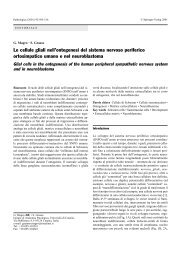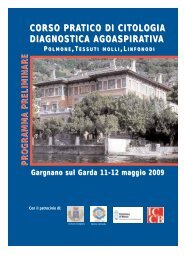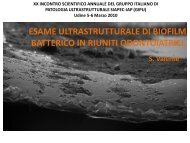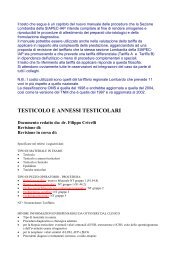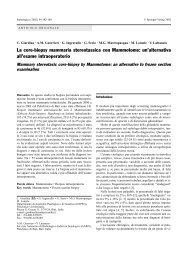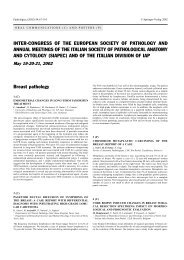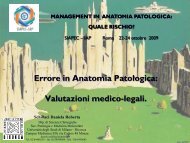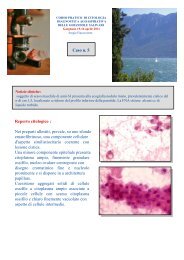pag. 216-318 - Siapec
pag. 216-318 - Siapec
pag. 216-318 - Siapec
Create successful ePaper yourself
Turn your PDF publications into a flip-book with our unique Google optimized e-Paper software.
244<br />
COMUNICAZIONI E POSTER<br />
risultati instabili, mentre BAT26 è risultato stabile; complessivamente<br />
il reperto è stato di alta instabilità (MSI-H). Questi risultati<br />
hanno indirizzato alla ricerca della mutazione germinale.<br />
L’analisi mutazionale in DHPLC non ha messo in evidenza<br />
mutazioni puntiformi nei geni MSH2 ed MLH1. La successiva<br />
analisi con multiplex ligation-dependent probe amplification<br />
(MLPA) ha messo in evidenza la delezione completa del<br />
gene MSH2. Le stesse analisi sono state poi effettuate su campioni<br />
istologici e su sangue del padre e sono state osservate le<br />
medesime alterazioni.<br />
Conclusioni<br />
Delezione completa di MSH2 è stata riscontrata nella nostra<br />
casistica solamente in questa famiglia ed in un’altra con carcinoma<br />
del colon destro a 36 aa. nel probando.<br />
La rilevanza del caso è data dalla giovane età di insorgenza,<br />
dalla situazione iniziale di apparente non-rischio famigliare,<br />
dalla stabilità del microsatellite BAT26 e dal tipo infrequente<br />
di mutazione riscontrata, cioè delezione completa del gene<br />
MSH2.<br />
Il dato di un’età così giovanile di insorgenza di carcinoma del<br />
colon deve essere tenuto in considerazione nella valutazione<br />
di tempi di sorveglianza colonscopica nelle famiglie<br />
HNPCC.<br />
Depletion of MTDNA limited to the external<br />
layer of muscularis propria induces<br />
gastrointestinal dysmotility in a MNGIE<br />
patient<br />
C. Giordano, M. Sebastiani, C. Travaglini, P. Sale, M.L.<br />
Valentino * , V. Carelli * , G. d’Amati<br />
Dipartimento di Medicina Sperimentale e Patologia, Università<br />
di Roma “La Sapienza”; * Dipartimento di Scienze Neurologiche,<br />
Università di Bologna<br />
Introduction<br />
Mitochondrial neurogastrointestinal encephalomyopathy<br />
(MNGIE) is an autosomal recessive disease clinically defined<br />
by severe gastrointestinal dysmotility, cachexia, ptosis,<br />
ophthalmoparesis, peripheral neuropathy, white matter<br />
changes in brain MRI, and mitochondrial abnormalities.<br />
Loss-of-function mutations in thymidine phosphorylase (TP)<br />
gene induce pathologic accumulations of thymidine and deoxyuridine,<br />
which generate mtDNA defects (depletion, multiple<br />
deletions and point mutations).<br />
The origin of gastrointestinal dysmotility is currently unclear.<br />
Material and methods<br />
We present a detailed histological description of the gastrointestinal<br />
tract of a patient carrying the homozygous TP<br />
mutation 1443G > A and, by the mean of laser capture microdissection,<br />
correlate the morphological findings with<br />
mtDNA abnormalities.<br />
Results<br />
Small intestine showed marked atrophy of the external layer<br />
of muscularis propria, with evidence of cytoplasmic vacuolization,<br />
mitochondrial proliferation and nuclei with condensed<br />
chromatin. In contrast, the internal layer and the<br />
myenteric and submucosal plexi were unremarkable. Genetic<br />
analysis revealed strikingly selective depletion of mtDNA<br />
in the small intestine, compared to esophagus, stomach and<br />
colon. Microdissection of the small intestine revealed depletion<br />
of mtDNA only in the external layer of muscularis propria.<br />
Interestingly, analysis of the gastrointestinal tract from<br />
ten controls revealed a non-homogeneous distribution of<br />
mtDNA content; the small intestine had the lowest levels of<br />
mtDNA. Multiple deletions were detected only in the upper<br />
esophagus and in skeletal muscle. Site-specific somatic point<br />
mutations, mostly T > C transitions preceded by 5’poly-A sequences,<br />
were detected at low abundance both in the muscle<br />
and nervous tissue of the gastrointestinal tract.<br />
Conclusions<br />
We conclude that profound mtDNA depletion in the external<br />
layer of muscularis propria is the major determinant for the<br />
morphologic changes and indicates that visceral myopathy is<br />
responsible for gastrointestinal dysmotility in this MNGIE<br />
patient. Our results suggest that tissues with constitutively<br />
low amounts of mtDNA may be more sensitive to defects of<br />
thymidine phosphorylase.<br />
Epstein-Barr virus infection in gastric<br />
carcinomas with peritumoral neutrophil<br />
infiltration<br />
A. Ieni, G. Niedobitek * , T. Kirchner * , R.A. Caruso, C. Inferrera<br />
Dipartimento di Patologia umana Messina; * Institute Of<br />
Pathology, University Of Erlangen, Germany<br />
The Epstein-Barr virus is a ubiquitous human herpesvirus<br />
which establishes a life-long persistent infection of B-cells in<br />
over 90% of the human adult population. The association of<br />
Epstein-Barr virus (EBV) with a proportion of gastric carcinomas<br />
is well established. We have recently identified tumour<br />
infilration by neutrophils as a potential indicator of a<br />
favourable prognosis in advanced gastric cancer (AGC). Here<br />
we have tested the hypothesis that infiltration by neutrophils<br />
may be related to EBV infection of the tumour cells.<br />
Methods<br />
One hundred cases of gastric carcinomas (50 carcinomas with<br />
peritumoral neutrophil infiltration – 50 gastric adenocarcinomas<br />
without stromal inflammatory reaction) were analysed by<br />
in Situ Hybridization for the detection of the EBV-encoded<br />
small nuclear RNAs (EBERs) 35S-labelled probes were employed<br />
and bound probes were detected by autoradiography.<br />
Results<br />
In situ hybridization showed EBV infection of the tumour<br />
cells in one case of neutrophil-rich gastric carcinoma and in<br />
one case of ordinary carcinoma (2%). In one of these cases,<br />
EBV infection was detected both in tumour tissue and in the<br />
adjacent non-neoplastic mucosa. These data confirm that<br />
Epstein-Barr virus infection is rarely associated with gastric<br />
carcinoma and show that EBV is not preferentially found in<br />
AGC with neutrophils. Furthermore we provide evidence of<br />
viral infection of non-neoplastic gastric mucosa.<br />
Congenital malignant peripheral nerve<br />
sheath tumor of the small bowel<br />
unassociated with von Recklinghausen’s<br />
disease: a heretofore unreported occurrence<br />
E. Kuhn, F. Pallotti, L. Runza, S. Carinelli<br />
U.O. Anatomia Patologica, Ospedale Maggiore Policlinico<br />
“Mangiagalli - Regina Elena”, Milano, Italia<br />
Introduction<br />
Malignant peripheral nerve sheath tumor (MPNST) in children<br />
is uncommon, and is frequently associated with von





